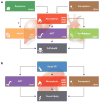Necroptosis: Mechanisms and Relevance to Disease
- PMID: 27959630
- PMCID: PMC5786374
- DOI: 10.1146/annurev-pathol-052016-100247
Necroptosis: Mechanisms and Relevance to Disease
Abstract
Necroptosis is a form of regulated cell death that critically depends on receptor-interacting serine-threonine kinase 3 (RIPK3) and mixed lineage kinase domain-like (MLKL) and generally manifests with morphological features of necrosis. The molecular mechanisms that underlie distinct instances of necroptosis have just begun to emerge. Nonetheless, it has already been shown that necroptosis contributes to cellular demise in various pathophysiological conditions, including viral infection, acute kidney injury, and cardiac ischemia/reperfusion. Moreover, human tumors appear to obtain an advantage from the downregulation of key components of the molecular machinery for necroptosis. Although such an advantage may stem from an increased resistance to adverse microenvironmental conditions, accumulating evidence indicates that necroptosis-deficient cancer cells are poorly immunogenic and hence escape natural and therapy-elicited immunosurveillance. Here, we discuss the molecular mechanisms and relevance to disease of necroptosis.
Keywords: caspases; damage-associated molecular patterns; immunogenic cell death; inflammation; mitochondrial permeability transition; necrostatin-1.
Figures


References
Publication types
MeSH terms
Substances
Grants and funding
LinkOut - more resources
Full Text Sources
Other Literature Sources
Miscellaneous

